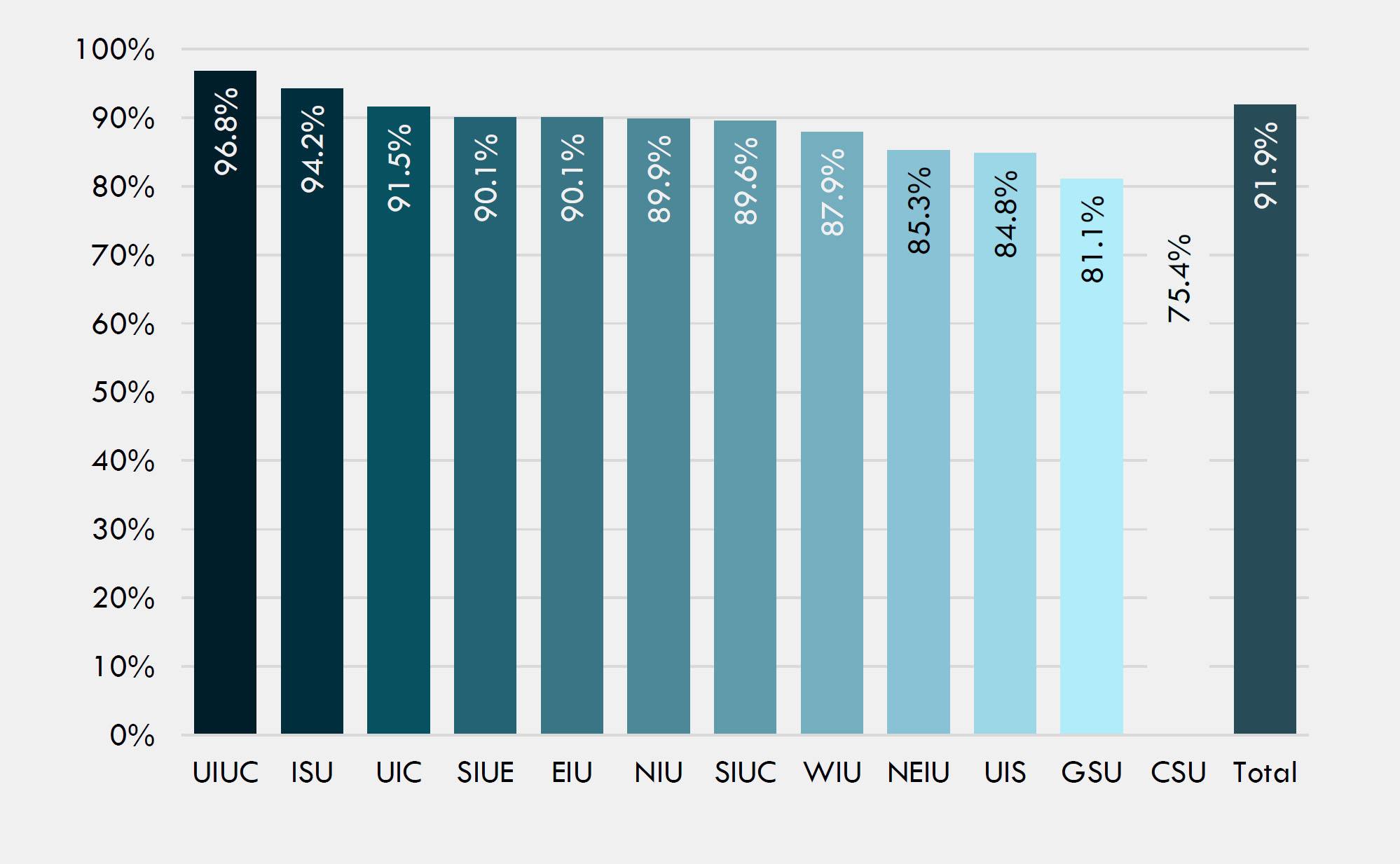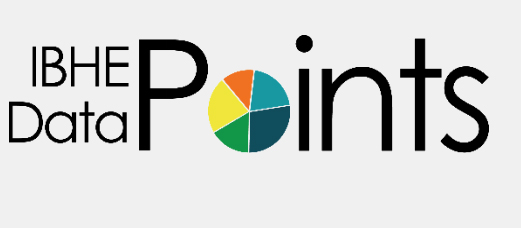
FIRST LOOK: PUBLIC UNIVERSITY SPRING ENROLLMENT ACADEMIC YEAR 2020-21
HIGHLIGHTS
Spring AY2019-20 to Spring AY 2020-21 Patterns
Overall spring enrollment at Illinois public universities increased by +1.1% relative to last year, which is notable given the COVID-19 pandemic.
Undergraduate enrollment was down by -0.7%, while graduate and professional enrollment was up by +5.4%.
Illinois public universities fared better than the national average in terms of undergraduate enrollment. During the same timeframe, nationally, undergraduate enrollment declined by –2.9%. 1
Overall African American enrollment was down marginally (-0.2%), with small declines in undergraduate enrollment (-2.5%) and growth in graduate and professional enrollment (+7.2%).
Latinx enrollment was up +6.0%, with robust growth in graduate/professional enrollment (+14.8%) and smaller growth in undergraduate enrollment (+4.3%).
There were robust enrollment declines among international students2 at both the undergraduate and graduate levels.
Fall AY 2020-21 to Spring AY 2020-21 Patterns
91.9% of all undergraduate students who were enrolled during the fall semester of AY 2020-21 at Illinois public universities were retained in the spring of AY 2020-21.
African American undergraduate students were retained at comparatively lower rates (85%) relative to their white (93%) and Latinx (90%) peers.
Overview
In recent years, IBHE has periodically released information specific to spring enrollment at the Illinois public universities. Considering the COVID-19 pandemic and IBHE’s continued focus on equity, IBHE collaborated with the Illinois public universities to capture spring enrollment information for academic year 2020-21 with a first-ever early look at fall to spring retention and equity. Changes in enrollment from spring of AY2019-20 to spring of AY2020-21 are emphasized in this report. In addition to providing information on some of the more nuanced enrollment types, like dual credit, the interaction of race/ethnicity and gender specific to spring to spring enrollment is also included in the report.
¹ COVID-19: Stay Informed - National Student Clearinghouse Research Center (nscresearchcenter.org)
² A person who is not a citizen or national of the United States and who is in this country on a visa or temporary basis.
Spring of Academic Year 2019-20 to Spring of 2020-21 Enrollment
Total Enrollment. Illinois public universities experienced an increase in total enrollment of 1.1% from spring of AY 2019-20 to spring of AY 2020-21, which equated to slightly more than 1,800 students. Three public universities experienced spring over spring increases in total enrollment: EIU (+13.2%); UIUC (+4.9%); and UIC (+0.7%).
Table 1: Spring Enrollment for Illinois Public Universities: Total Enrollment
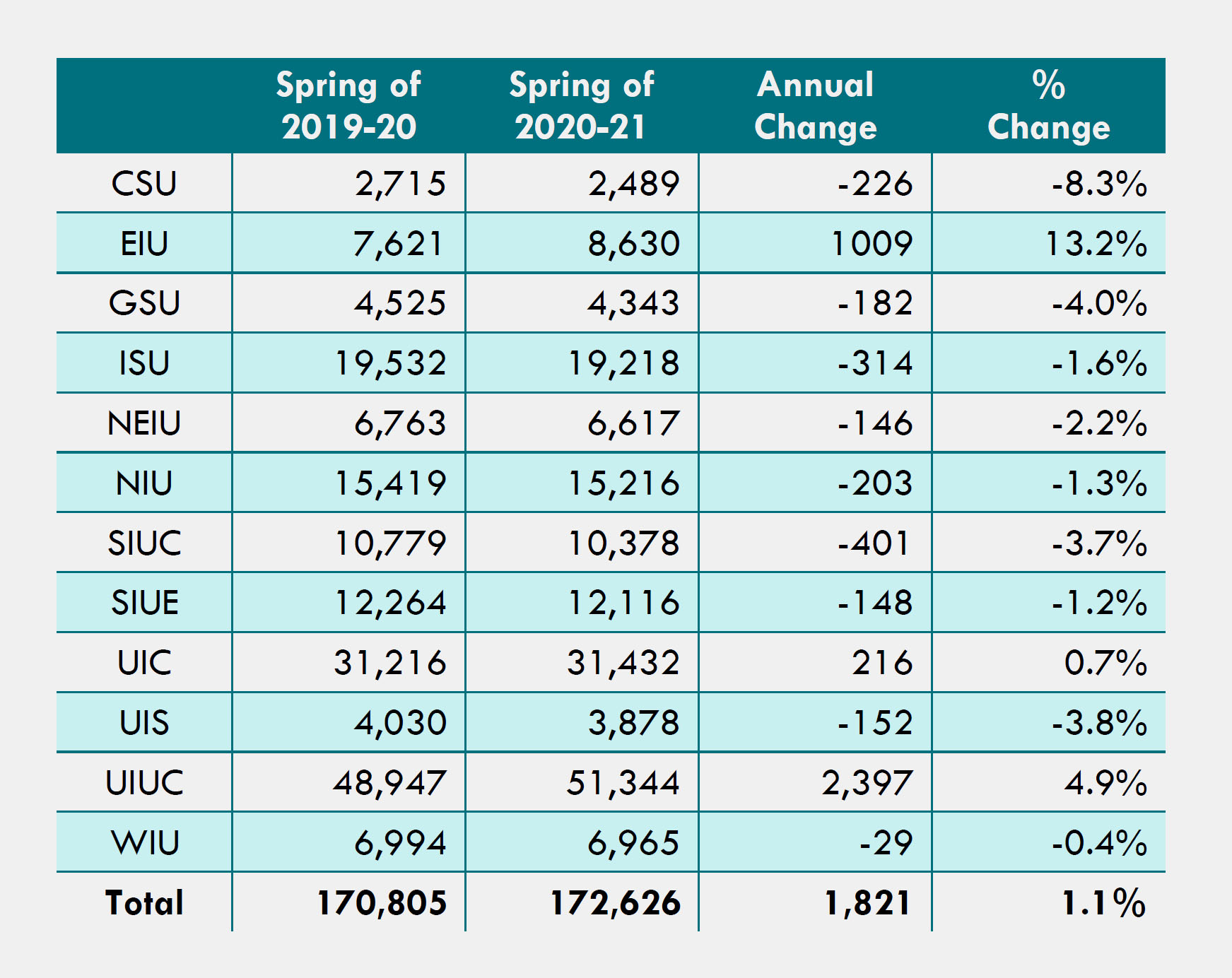
Undergraduate Enrollment. Undergraduate enrollment declined at Illinois public universities by -0.7% from spring of 2019-20 to spring of 2020-21. It should be noted that the decline in undergraduate enrollment was moderated by the robust increase in dual credit enrollment (+1,005 dual credit students) at EIU. Most of the public universities experienced year over year declines in undergraduate enrollment. The few that did not, experienced slight year-over-year growth, namely UIUC (+0.9%) and UIC (+0.2%). Factoring out dual credit, EIU experienced an increase in undergraduate enrollment of +1.0% or 42 students.
Table 2: Spring Enrollment for Illinois Public Universities: Undergraduate Enrollment*
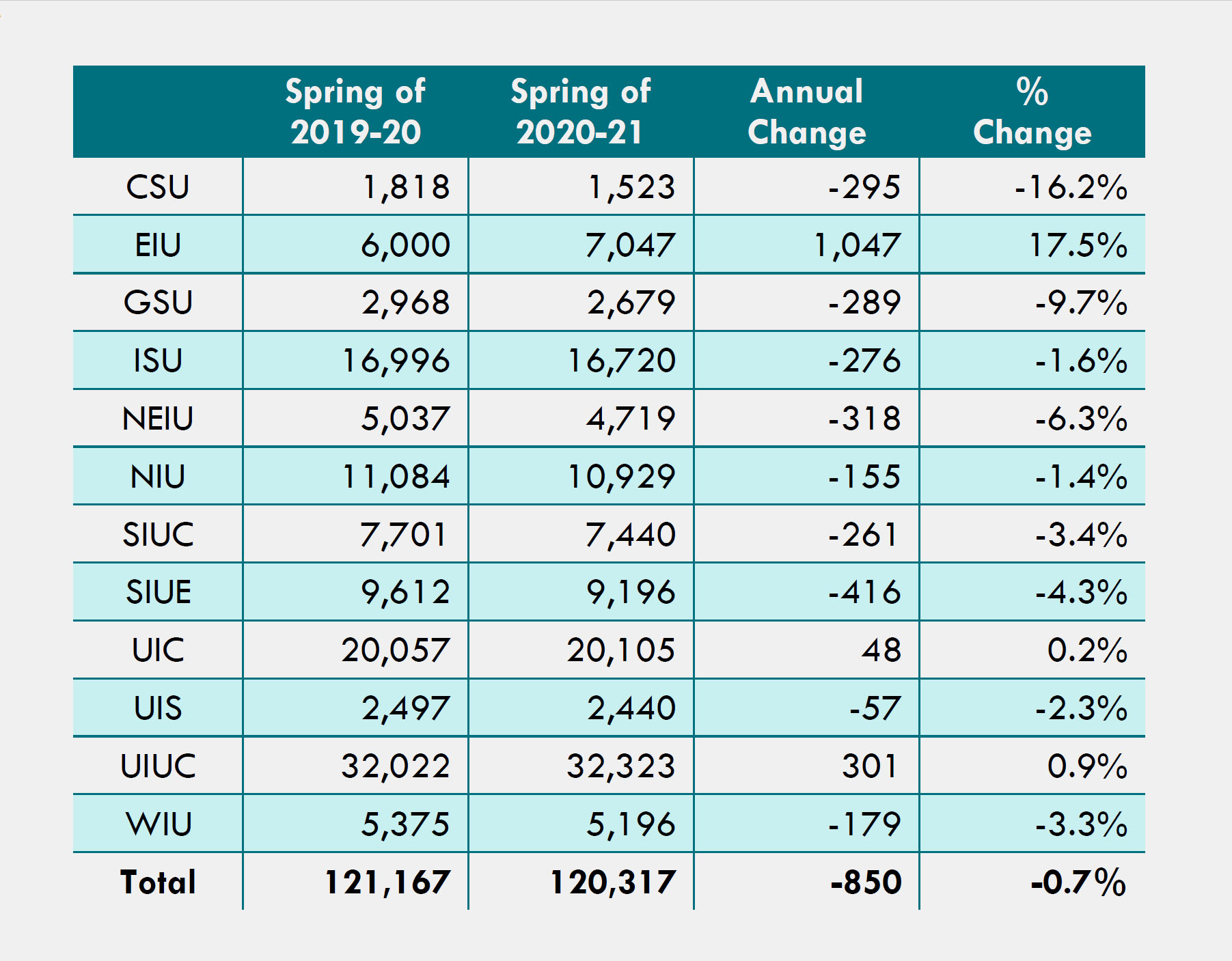
* Includes non-degree seeking students, such as those enrolled via dual credit and dual enrollment programs.
Graduate and Professional Enrollment. Overall graduate and professional enrollment increased by 5.4% from spring of AY 2019-20 to spring of AY 2020-21. Several of the public universities experienced growth in the graduate and professional enrollment and a few had double digit increases including UIUC (+12.4%); SIUE (+10.1%); NEIU (+10.0%); with WIU slightly below 10% (+9.3%) and CSU at nearly +8%.
Table 3: Spring Enrollment for Illinois Public Universities: Graduate/Professional Enrollment

Dual Credit and Dual Enrollment. Dual credit and dual enrollment were up by 53.9% year over year. Nearly all the growth was attributable to EIU as they accounted for 95% of the annual increase.
Table 4: Spring Enrollment for Illinois Public Universities: Dual Credit/Dual Enrollment*
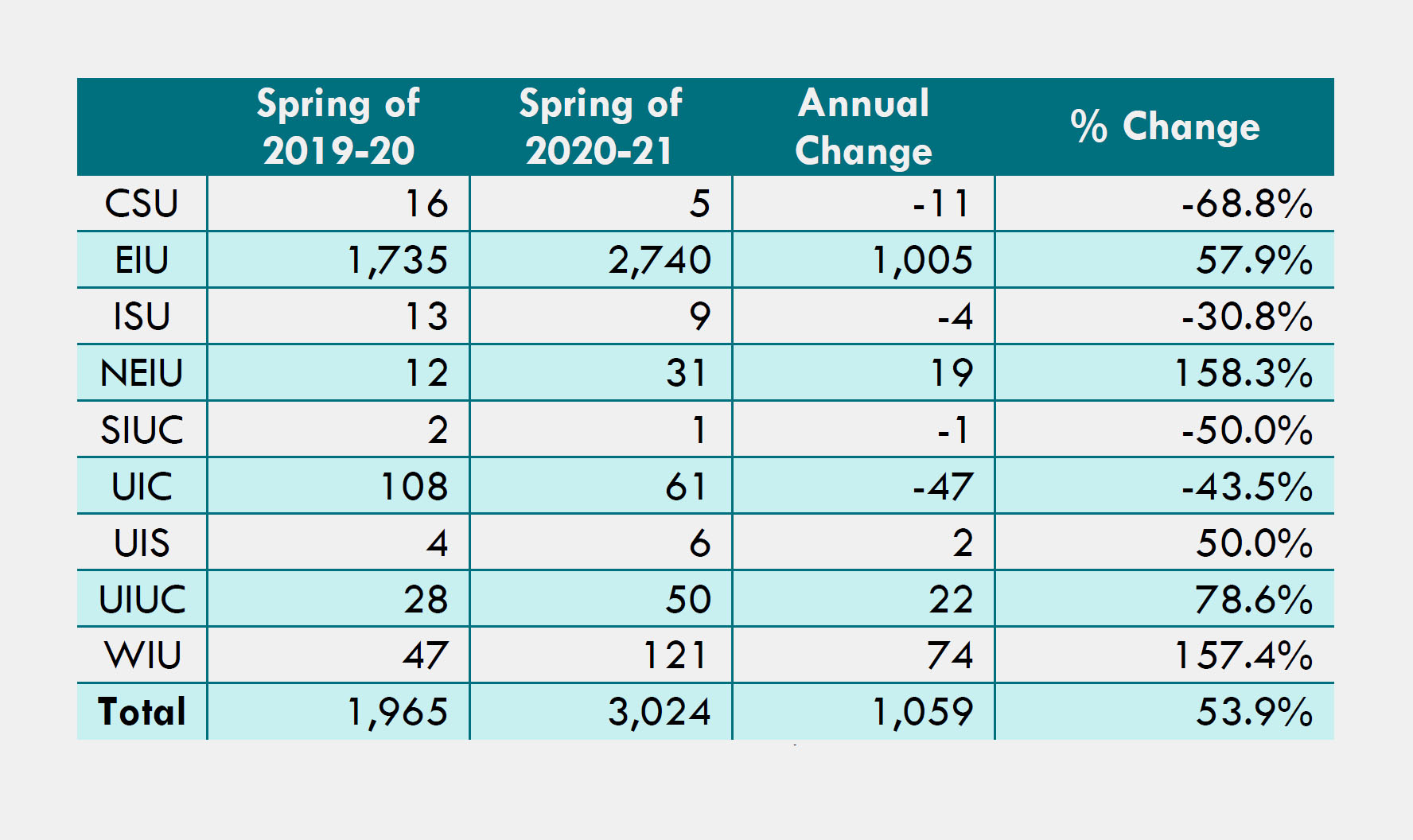
*GSU, NIU, SIUE did not report any dual credit/enrollment during spring of 2020-21.
Enrollment by Gender and Race/Ethnicity. Figure 1 depicts spring to spring enrollment by both race/ethnicity and gender for the Illinois public universities. Overall, female undergraduate enrollment was up by +0.8%, with a decline among male undergraduates (-2.3%). Males experienced marginally larger enrollment growth at the graduate/professional levels (+5.8%) relative to their female counterparts (+5.1%).
Latinx undergraduate enrollment increased by over 4% and there was well over double-digit growth in graduate/professional enrollment for both males and females. Undergraduate African American enrollment declined significantly more for males (-5.2%) than females (-0.8%), while graduate and professional enrollment moderately increased for both males and females. Illinois public universities experienced significant enrollment declines among international students at both the undergraduate and graduate/professional levels, with greater losses among female international students. The White undergraduate enrollment decline was -3.2% among females and -2.3% among males. For graduate and professional enrollment White males experienced a relatively larger year-over-year increase when compared to White females (+9.5% to +3.2%).
Figure 1: Change in Headcount Enrollments at Illinois Public Universities by Enrollment Type: Change from Spring 2019-20 to Spring 2020-21
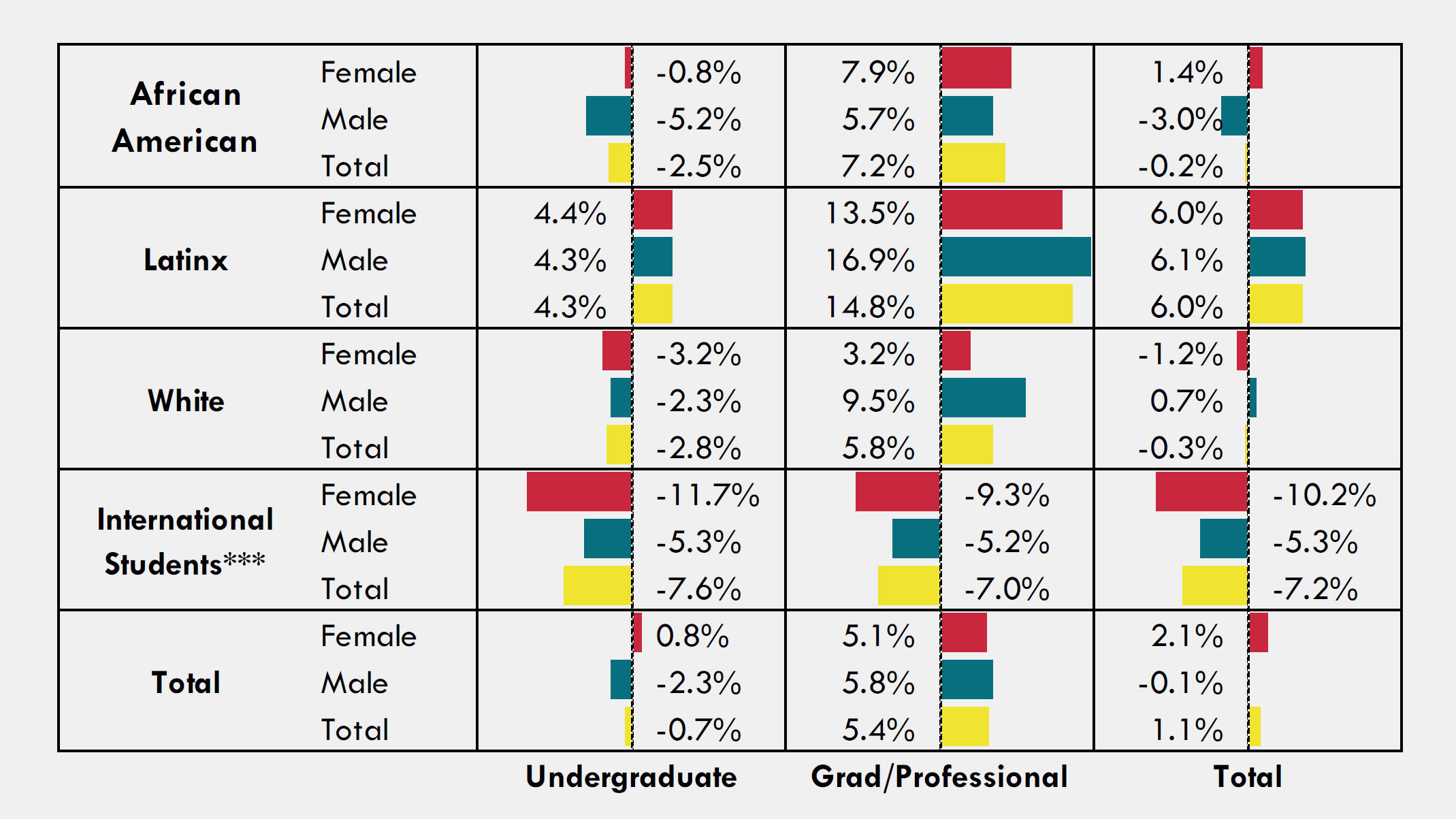
***A person who is not a citizen or national of the United States and who is in this country on a visa or temporary basis
Academic Year 2020-21 Fall to Spring Retention
Fall to Spring Retention by Race/Ethnicity. Figure 2 depicts the fall to spring retention rates among all degree and certificate seeking undergraduate students at Illinois public universities and disaggregates the information by race/ethnicity.1 More than nine out of every ten (91.9%) undergraduates at Illinois public universities who were enrolled in the fall of AY 2020-21 were still enrolled in the spring semester. There were some differences when the retention rates were disaggregated by race/ethnicity. A nearly nine percentage point retention gap was evident between African American undergraduates (84.7%) and their white peers (93.4%). The retention gap between Latinx undergraduates and their white counterparts was smaller and around three percentage points.
Figure 2: AY 2020-21: Fall to Spring Retention at Illinois Public Universities by Race/Ethnicity
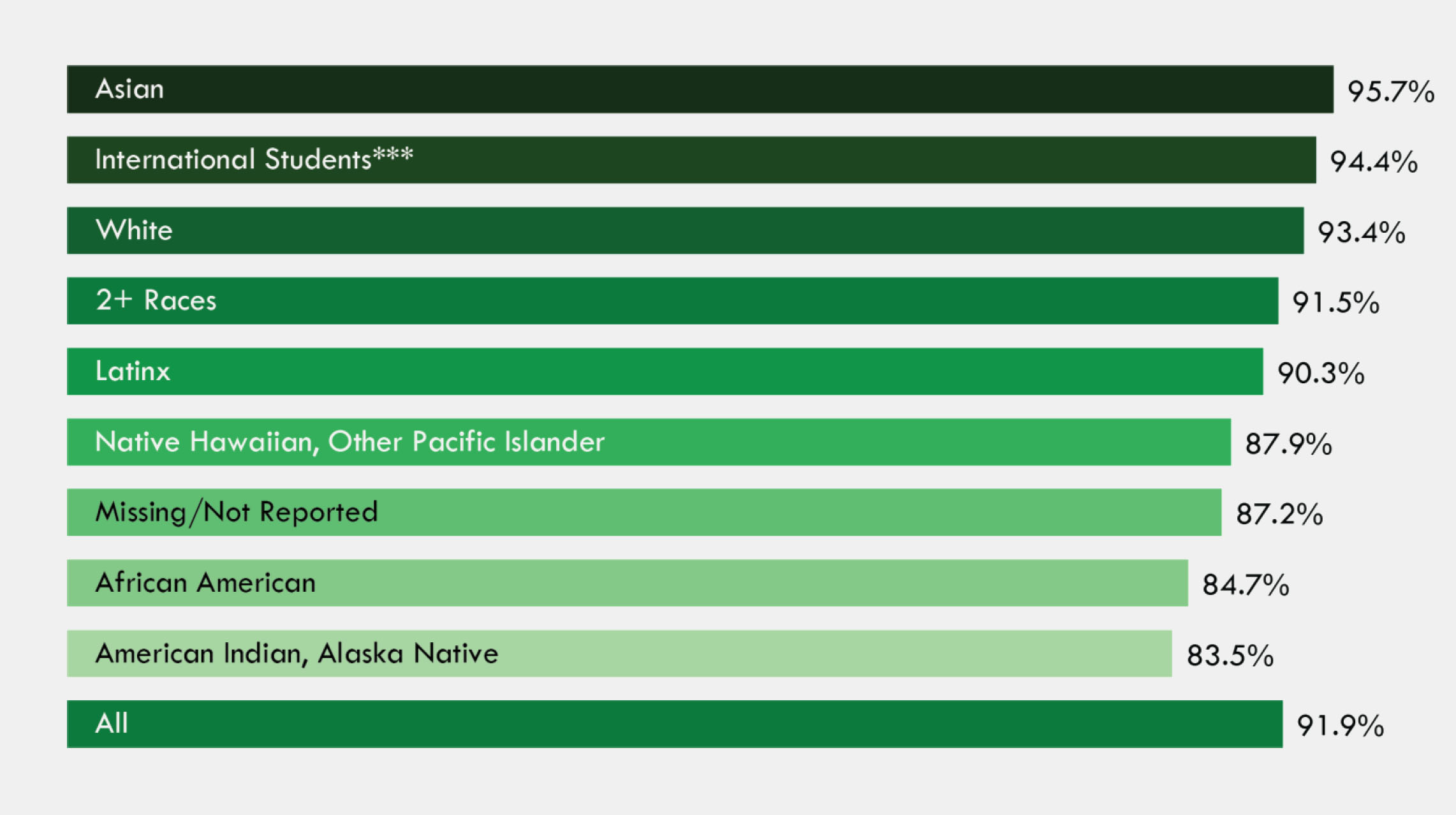
¹ It should be noted that fall semester graduates were excluded from both parts of the retention rate calculations (the numerator and the denominator). The retention rate calculations used in this report may vary from how public universities calculate fall to spring retention locally. Because it is also a positive outcome, some public universities include fall graduates in their fall to spring retention rate calculations. In future IBHE spring enrollment reports, information on fall graduates will be presented separately and in a complementary fashion to retention.
Fall to Spring Retention. As illustrated in Figure 3, there was variation across the twelve Illinois public universities in terms of fall to spring retention for undergraduate certificate and degree-seeking students. UIUC had the highest fall to spring retention rate at 96.8%, followed by ISU at 94.2%, while CSU had the lowest rate at 75.4%.
Figure 3: AY 2020-21 Fall to Spring Undergraduate Retention for Illinois Public Universities
